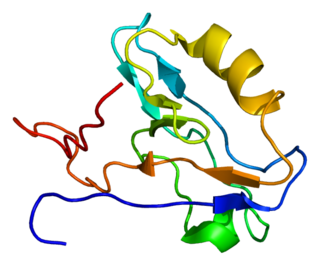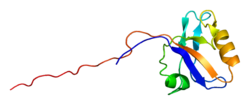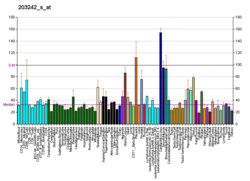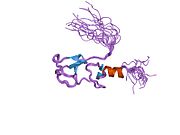
Frizzled-7(Fd-7) is a protein that in humans is encoded by the FZD7 gene.

Sodium channel subunit beta-3 is a protein that in humans is encoded by the SCN3B gene. Two alternatively spliced variants, encoding the same protein, have been identified.

Dipeptidyl aminopeptidase-like protein 6 is a protein that in humans is encoded by the DPP6 gene.

PDZ and LIM domain protein 7 is a protein that in humans is encoded by the PDLIM7 gene.

Membrane-associated guanylate kinase, WW and PDZ domain-containing protein 2 also known as membrane-associated guanylate kinase inverted 2 (MAGI-2) and atrophin-1-interacting protein 1 (AIP-1) is an enzyme that in humans is encoded by the MAGI2 gene.

PDZ and LIM domain protein 4 is a protein that in humans is encoded by the PDLIM4 gene.

Myosin-XVIIIa is a protein that in humans is encoded by the MYO18A gene.

LIM domain binding 3 (LDB3), also known as Z-band alternatively spliced PDZ-motif (ZASP), is a protein which in humans is encoded by the LDB3 gene. ZASP belongs to the Enigma subfamily of proteins and stabilizes the sarcomere during contraction, through interactions with actin in cardiac and skeletal muscles. Mutations in the ZASP gene has been associated with several muscular diseases.

Membrane-associated guanylate kinase, WW and PDZ domain-containing protein 3 is an enzyme that in humans is encoded by the MAGI3 gene.

Tax1-binding protein 3 is a protein that in humans is encoded by the TAX1BP3 gene. This name is in reference to the Tax1 protein of the Human T-cell Lymphotropic Virus (HTLV) which was used to discover Tax1BP3 in a yeast 2-hybrid screen and subsequently verified by co-IP. TIP1, as it is also known, is a PDZ domain containing protein. However, unlike most PDZ domain proteins which act as scaffolds and often contain multiple PDZ domains as well as other protein domains, TIP1 is essentially just the PDZ domain. This has led to the speculation that TIP1 acts as an inhibitor, either acting to separate PDZ binding motifs from their normal targets or simply preventing the protein to migrate away from the cytosol.

PDZ domain-containing protein 11 is a protein that in humans is encoded by the PDZD11 gene.

LIM/homeobox protein Lhx6 is a protein that in humans is encoded by the LHX6 gene.

Cysteine-rich PDZ-binding protein is a protein that in humans is encoded by the CRIPT gene.

Neuroepithelial cell-transforming gene 1 protein is a protein that in humans is encoded by the NET1 gene.

Mitochondrial carrier homolog 1 (MTCH1), also referred to as presenilin 1-associated protein (PSAP), is a protein that in humans is encoded by the MTCH1 gene on chromosome 6. MTCH1 is a proapoptotic mitochondrial protein potentially involved in Alzheimer’s disease (AD).

Histone-lysine N-methyltransferase KMT5B is an enzyme that in humans is encoded by the KMT5B gene. The enzyme along with WHSC1 is responsible for dimethylation of lysine 20 on histone H4 in mouse and humans.

PDZ domain-containing RING finger protein 3 is a protein that in humans is encoded by the PDZRN3 gene.

Actin-associated LIM protein (ALP), also known as PDZ and LIM domain protein 3 is a protein that in humans is encoded by the PDLIM3 gene. ALP is highly expressed in cardiac and skeletal muscle, where it localizes to Z-discs and intercalated discs. ALP functions to enhance the crosslinking of actin by alpha-actinin-2 and also appears to be essential for right ventricular chamber formation and contractile function.

PDZ and LIM domain protein 2 is a protein that in humans is encoded by the PDLIM2 gene.

Contactin-associated protein-like 4 is a protein that in humans is encoded by the CNTNAP4 gene.





























